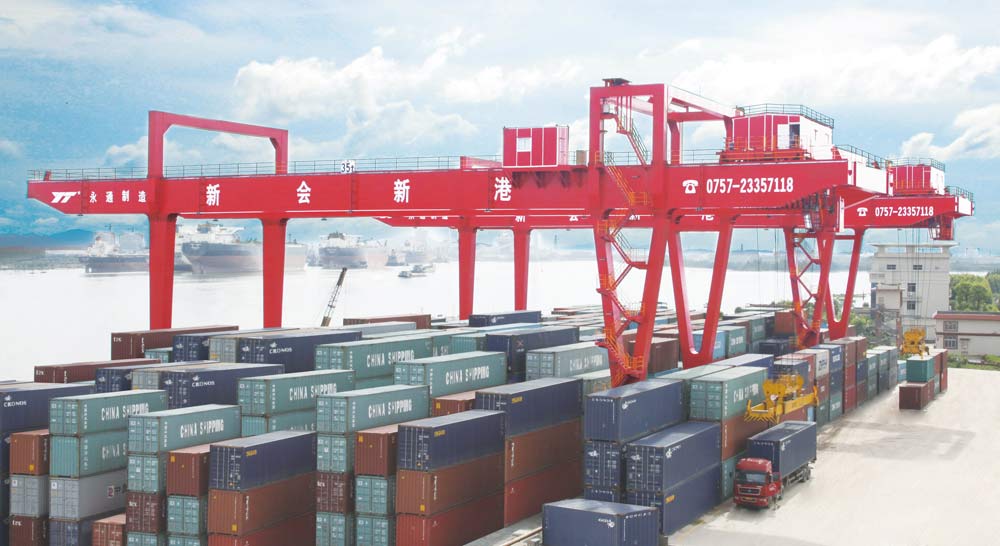The rail Mounted container gantry crane is a sophisticated piece of equipment essential for the efficient handling of containers in shipping and intermodal terminals. Its design is tailored to meet the specific needs of container storage and transportation, influenced by the operational requirements of the yard.

Key Components of a Rail Mounted Container Gantry Crane
The structure of a rail Mounted container gantry crane consists of several critical components:
Main Beam: This horizontal beam spans the width of the crane and supports the trolley, hoisting system, and the containers being lifted. It is typically constructed from high-strength steel to withstand heavy loads.
Legs: The legs, which can be rigid or flexible, support the main beam and connect it to the ground or rail system. They are essential for maintaining stability during operation.
Traveling Trolley: This mobile platform runs along the main beams and houses the hoisting mechanism responsible for lifting and lowering containers.
Lifting Mechanism: This includes a hoist drum, ropes, and pulleys that enable vertical movement of the containers. The hoist system must be robust to ensure safety during lifting operations.
Crane Traveling Mechanism: This allows the crane to move along its designated path, either on fixed rails or via rubber tires, depending on the crane's design (Rail-Mounted Gantry (RMG) or Rubber-Tired Gantry (RTG)).
Electrical System: Powers all operational components, including motors for trolley movement and lifting mechanisms.
Operating Cab: Provides a space for operators to control crane movements and monitor operations.
Cantilever Design Variations
The design of gantry cranes can vary significantly based on operational needs:
Non-Cantilever Type: These cranes do not extend beyond their main structure. They are stable and suitable for open spaces where additional reach is unnecessary. Their simpler design makes them cost-effective and easier to maintain.
Single Cantilever Type: This design features one arm extending from one side of the main beam, allowing access over obstacles or into confined spaces. It is ideal for operations requiring flexibility in tight areas.
Double Cantilever Type: With arms extending from both sides, this configuration offers enhanced stability and load distribution. It is suitable for larger operations where significant lifting capacities are needed across wide areas.
Operational Process
The operation process of a Rail Mounted container gantry crane typically follows these steps:
Positioning: The crane is positioned over the container to be lifted.
Trolley Movement: The trolley moves horizontally until it is directly above the container.
Lowering Spreader: The spreader is lowered onto the container with careful control to ensure proper engagement.
Lifting: Once secured, the hoisting mechanism lifts the container vertically.
Transporting: The trolley moves horizontally to transport the lifted container to its destination, whether that be a truck loading area or a storage stack.
Lowering Container: The container is lowered into place once it reaches its destination.
Releasing Container: After placement, the spreader disengages from the container, allowing for subsequent operations.
Rail Mounted container gantry cranes are designed with various structural forms—non-cantilevered, single cantilevered, and double cantilevered—to accommodate different operational requirements in container handling environments. Their robust construction and versatile designs enable efficient management of heavy loads in busy shipping terminals and intermodal yards.
Yes, because the working condition are different, all our products are customized depending on detail requirement! So all your products will be specially designed by our engineers according to your workshop conditions.
Yes, all kinds of certification are available, if you have doubt, you can come to our factory and test it by yourself,or you can let some third-partied to do the inspection for you.
Yes, we have. But we only have the standard-sized products, if you need customized products, then it will take some time to manufacture it.
It depends on your products quantity and products data you given, but we will try our best to deliver your products as soon as possible.
We will sent you the detail installation manual or if you are needing, our installation engineers can come to your workshop to guide the installation.
You can come to our factory anytime when you are convenient. We will make arrangement to pick you up.